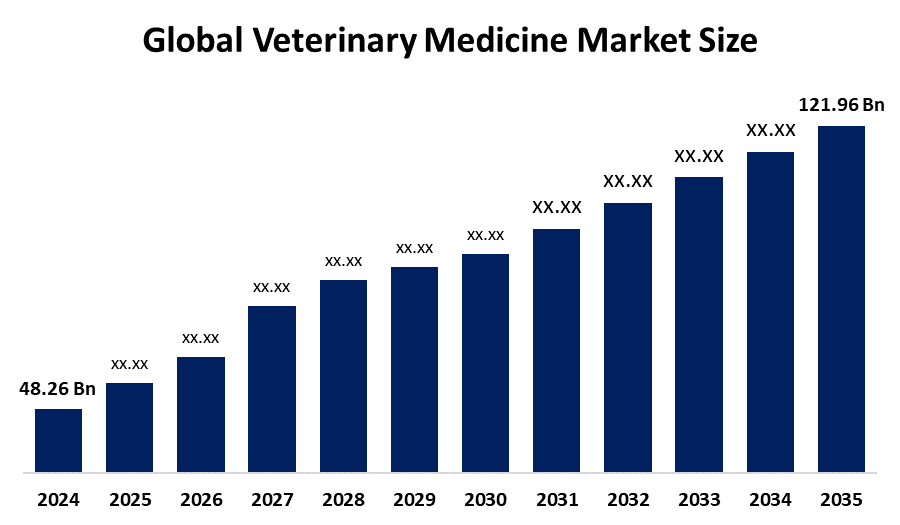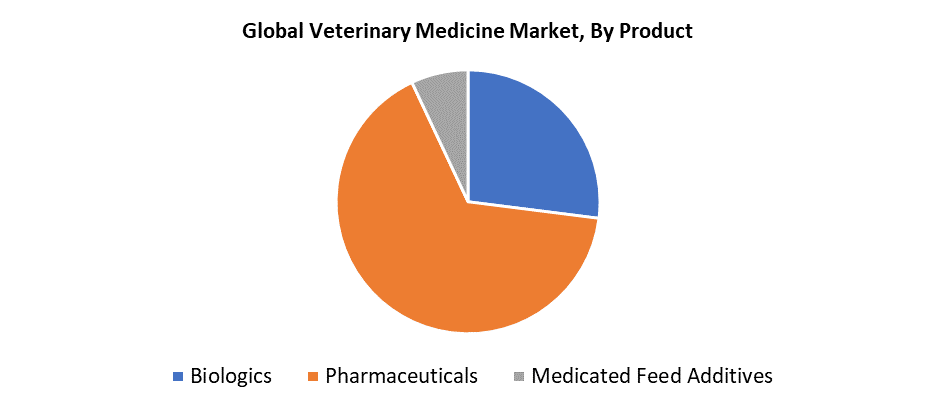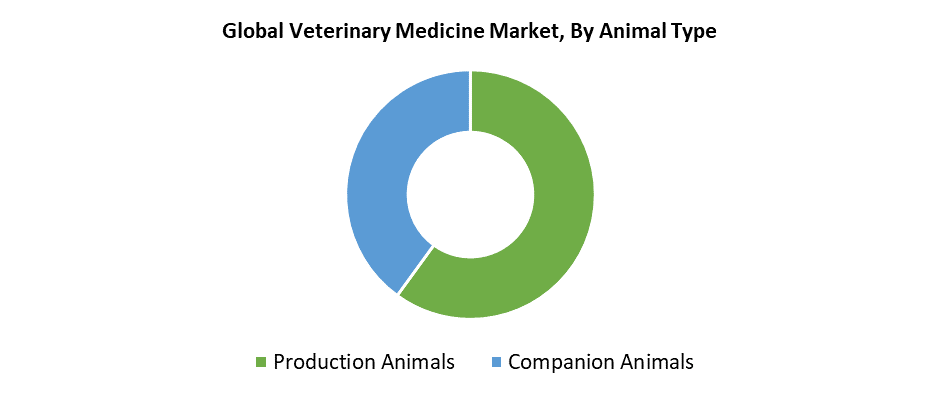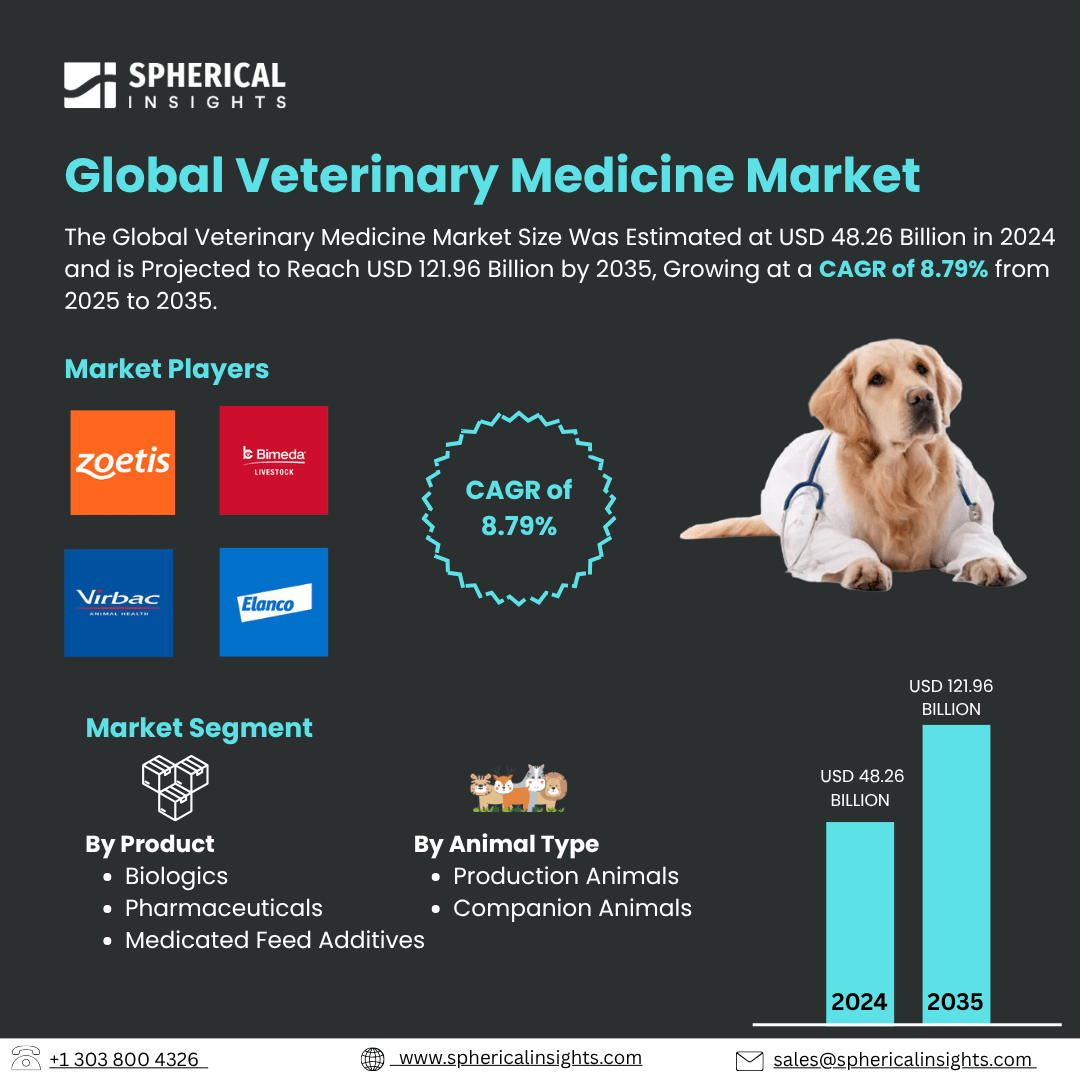Veterinary Medicine Market Summary
The Global Veterinary Medicine Market Size Was Estimated at USD 48.26 Billion in 2024 and is Projected to Reach USD 121.96 Billion by 2035, Growing at a CAGR of 8.79% from 2025 to 2035. Improvements in veterinary technology, a greater emphasis on animal welfare, and rising pet ownership are the main factors propelling the veterinary medicine market's expansion.
Key Regional and Segment-Wise Insights
- In 2024, the global veterinary medicine market will be dominated by the North America region, accounting for the largest revenue share.
- Throughout the forecast period, the Asia Pacific veterinary medicine market is anticipated to grow at the fastest rate.
- In terms of product, the pharmaceuticals segment accounted for 66.73% of the market revenue share in 2024.
- In 2024, the producing animals segment held the largest revenue share based on animal type.
Global Market Forecast and Revenue Outlook
- 2024 Market Size: USD 48.26 Billion
- 2035 Projected Market Size: USD 121.96 Billion
- CAGR (2025-2035): 8.79%
- North America: Largest market in 2024
- Asia Pacific: Fastest growing market

The veterinary medicine market consists of businesses that produce and distribute medical products and pharmaceuticals for animal care. The expansion of veterinary medical treatment occurs because government organizations focus on food security, along with sustainable agricultural practices and animal protection. Regulatory authorities operating throughout the Asia Pacific region have established rigorous requirements for the approval procedures, production methods, and distribution channels of veterinary medical products, including vaccines and feed additives. The implemented measures establish trust in animal health solutions through their assurance of safe and effective products with high-quality standards. The rise in urbanization, combined with the growing pet ownership trend, has elevated demand for veterinary care because people now seek regular checkups and preventive treatments for their pets. The knowledge about animal health and welfare among livestock farmers and pet owners leads to increased adoption of regular veterinary checkups and preventative medicine.
Veterinary care proves essential for controlling disease spread between animals and humans since zoonotic illnesses such as COVID-19 and avian influenza emerged. This awareness has led to increased funding for research, together with diagnostics and disease control measures. The demand for veterinary medicine in livestock production has risen because people want more meat and dairy, along with other animal-based products. Consumers require food safety and supply chain reliability, which makes it necessary to protect the health of farm animals. The veterinary medicine market in this region has experienced overall growth because of technological advancements, which include imaging equipment, laboratory diagnostics, and surgical breakthroughs that enhance disease identification and treatment methods.
Product Insights

The pharmaceuticals segment led the veterinary medicine market in 2024 by capturing 66.73% of revenue because of various essential factors. The demand for effective medicines, including anti-inflammatory agents, parasiticides, and anti-infectives, has increased because more people are adopting pets, especially in urban settings. The segment achieved growth through rising awareness about animal health and preventive care practices, which reached both livestock farmers and pet owners. Veterinary pharmaceutical technology advancements have led to enhanced medication safety and improved effectiveness. Research and development investments by pharmaceutical companies focus on developing new specific treatments for animal diseases, which will foster market expansion. The animal health sector values this segment as a fundamental element because people are dedicating more attention to preventive healthcare measures.
The veterinary medicine market's biological segment will experience the highest growth rate between 2025 and 2035 because of multiple essential factors. Biologics, including vaccinations together with immunomodulators and gene treatments, are gaining popularity due to rising animal health expenses and expanded understanding of preventive care. The increasing frequency of animal infectious and chronic diseases has made modern treatment alternatives essential. The major market players spend actively in R&D to develop new biologic solutions, which leads to increased new product launches. The market growth is driven by enhanced regulatory structures and expanding veterinary biologics access in emerging economies. This market expansion signals a shift toward customizable, long-lasting animal healthcare solutions with preventive measures.
Animal Type Insights

The production animals sector received the highest revenue share in the 2024 veterinary medication market because of rising demand for meat, milk, and eggs. The increasing intensification of livestock farming alongside world population growth drives up demand for veterinary services that maintain herd health while preventing outbreaks and ensuring productivity. This segment of the market includes cattle alongside poultry, swine, sheep, and fish for disease prevention, reproductive health management, and nutritional control. The growing interest in food safety, together with environmentally sustainable farming approaches and efficient production methods, drives up demand. The increase in demand receives additional support from advancements in livestock management technology and health monitoring systems, which make veterinary medicine essential for securing global food security objectives.
The companion animal segment is projected to generate profitable growth during the forecast period because of rising pet ownership rates, alongside pet humanization trends and increasing pet care expenses. Dogs and cats remain the most common pets, while their demand for advanced veterinary services and specific drug formulations keeps rising. The market expands due to the availability of specialized treatments, as well as preventive care options and an active research and development pipeline. This category includes both traditional pets, such as dogs and cats, and exotic animals, including birds, reptiles, and small mammals. The strong emotional bond between pet owners and their animals drives them to spend more money on pet healthcare services. The segment grows through rising diagnostic needs, dental care, immunizations, and premium pet products as animal welfare awareness increases.
Regional Insights
In 2024, North America led the global veterinary medicine market because of various critical elements. The market supremacy of big players such as Zoetis, Merck & Co., Elanco Animal Health, and Vetbiologics stems from their consistent innovation and strategic decisions. Advanced veterinary services experience growing demand because of rising pet ownership levels, pet humanization trends, and substantial pet care costs. The United States and Canada benefit from multiple advantages, which include a substantial population of companion and production animals, established veterinary healthcare systems, and a strong animal welfare emphasis. New medications and diagnostics, together with vaccinations, receive support from R&D investments and modern veterinary technologies. Strict regulatory requirements create a growing market need for products that are both safe and efficient in veterinary applications.
Europe Veterinary Medicine Market Trends
The European market for veterinary medicine accounted for consistent growth because animal welfare regulations demand veterinary products for protecting animal health and safety. The United Kingdom, along with Germany, France, and Italy, possesses both high pet ownership rates and well-developed veterinary healthcare systems. The region gives high importance to preventive care, together with disease control and public health concerns, especially regarding zoonotic diseases. The veterinary field experiences fast adoption of novel technologies through new medications, diagnostic tools, and therapeutic approaches. The market growth receives additional support from Europe's broad immunization initiatives, together with its strict regulatory system. Research collaborations, along with increased funding for veterinary science, drive the development of modern animal healthcare solutions, which are both effective and ethically responsible.
Asia Pacific Veterinary Medicine Market Trends
The Asia Pacific veterinary medicine market will experience the fastest growth rate throughout the forecast period because of urbanization, rising disposable incomes, and rapid economic expansion. The expanding middle class, along with increased metropolitan pet ownership, creates rising demand for veterinary care, medical treatments, and prevention services. The market growth stems from China, India, Japan, Australia, and the rising Southeast Asian markets. The region requires substantial veterinary supplies because it hosts large populations of both companion animals and production animals. Western veterinary practices introduced into the market, along with better livestock management and growing concerns about diseases transmitted from animals to humans, drive the market expansion. Animal health innovation and accessibility benefit from government programs alongside research development and infrastructure investments.
Key Veterinary Medicine Companies:
The following are the leading companies in the veterinary medicine market. These companies collectively hold the largest market share and dictate industry trends.
- Zoetis Inc.
- Bimeda Corporate
- Dechra Pharmaceuticals PLC
- Merck & Co., Inc.
- Virbac
- Phibro Animal Health Corporation
- Elanco
- Boehringer Ingelheim International Gmbh
- Ceva Santé Animale
- Biogénesis Bagó
- Others
Recent Developments
- In September 2024, Zoetis and Danone collaborated to advance sustainable dairy farming through innovative genetic approaches for better animal health and reduced environmental impacts. Zoetis' genetic testing tools, including the Dairy Wellness Profit Index, will help dairy producers develop tough animals that satisfy rising customer needs for eco-friendly dairy products through this partnership. The veterinary medicine market will enhance its capability to promote farm productivity along with animal welfare through this partnership.
- In August 2024, Boehringer Ingelheim India and Vvaan Lifesciences Pvt Ltd established a strategic distribution collaboration worth approximately USD 124.51 million to improve the company's pet parasiticide line and increase its market share in India's pet health sector. The goal of this partnership is to increase access to high-quality pet care in underserved and Tier 2 cities by utilizing Vvaan's experience to better serve these areas and raise the bar for veterinary care nationwide.
Market Segment
This study forecasts revenue at global, regional, and country levels from 2020 to 2035. Spherical Insights has segmented the veterinary medicine market based on the below-mentioned segments:
Global Veterinary Medicine Market, By Product
- Biologics
- Pharmaceuticals
- Medicated Feed Additives
Global Veterinary Medicine Market, By Animal Type
- Production Animals
- Companion Animals
Global Veterinary Medicine Market, By Regional Analysis
- North America
- Europe
- Germany
- UK
- France
- Italy
- Spain
- Russia
- Rest of Europe
- Asia Pacific
- China
- Japan
- India
- South Korea
- Australia
- Rest of Asia Pacific
- South America
- Brazil
- Argentina
- Rest of South America
- Middle East & Africa
- UAE
- Saudi Arabia
- Qatar
- South Africa
- Rest of the Middle East & Africa






